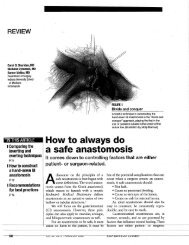SRPS PS - Plastic Surgery Internal
SRPS PS - Plastic Surgery Internal
SRPS PS - Plastic Surgery Internal
You also want an ePaper? Increase the reach of your titles
YUMPU automatically turns print PDFs into web optimized ePapers that Google loves.
<strong>SR<strong>PS</strong></strong> Volume 10, Issue 25, 2009<br />
complex probably accounts for the high recurrence<br />
rate. 163 Prevention of recurrence depends on<br />
identification and excision of the involved segment of<br />
joint capsule and deep attachments of the cyst pedicle<br />
to the scapholunate ligament but only minimal<br />
resection of the ligament itself to prevent future<br />
scapholunate dissociation (Fig. 10). 164 Clay and<br />
Clement 150 noted only 3.2% recurrence when using<br />
that protocol. More radical procedures pose a greater<br />
risk of subsequent stiffness, hypertrophic scar, wound<br />
infection, and nerve damage.<br />
Figure 10. Ganglion with pedicle attached to scapholunate<br />
ligament. (Reprinted with permission from Minotti and Taras. 164 )<br />
Filan and Herbert 165 think that symptomatic dorsal<br />
wrist ganglia are the result of scaphoid instability that,<br />
if present at the preoperative clinical examination, is<br />
treated by a dorsal capsulorrhaphy of the wrist<br />
combined with ganglion excision. Of seven patients<br />
who underwent surgery for recurrent ganglia in whom<br />
capsulorrhaphy was performed, none had experienced<br />
recurrence of ganglia at 12 months.<br />
The treatment of wrist ganglia is indicated only in<br />
the event of significant discomfort or deformity.<br />
Although surgery is the mainstay of treatment,<br />
various nonoperative techniques have been<br />
advocated. Aspiration 166,167 or injection of enzymes, 168<br />
sclerosing agents, or cortisone have been suggested,<br />
but all are associated with a significant recurrence<br />
rate. Arthroscopic resection of the ganglion might be<br />
associated with a lower recurrence rate. 169–171 It can also<br />
14<br />
identify the exact origin of the ganglion and other<br />
intra-articular pathological conditions.<br />
Giant Cell Tumors of Tendon Sheath<br />
Giant cell tumors are the second most frequent type of<br />
hand tumor. They typically occur in the fingers of 20to<br />
40-year-old patients and are slightly more common<br />
in women. Giant cell tumors of the tendon sheath are<br />
also known as pigmented villonodular synovitis when<br />
they arise from the volar joint recess. 172,173 No evidence<br />
has shown that repeated hemorrhage, friction, or<br />
cholesterol imbalance contributes significantly to the<br />
development of giant cell tumors, and only<br />
approximately one-third of patients provide histories<br />
of previous trauma or surgery to the region. Pain and<br />
tenderness are not prominent features, but prolonged<br />
unchecked tumor growth interferes with mechanical<br />
function of the hand.<br />
The clinical presentation of a giant cell tumor of<br />
the tendon sheath is that of a lobulated, mottled,<br />
yellow subcutaneous mass. Although the diagnosis<br />
usually is evident clinically, magnetic resonance<br />
imaging (MRI) has been described as an adjunct in the<br />
preoperative assessment of extensive tumors. 174 The<br />
characteristic lobulation is seen microscopically, and a<br />
relatively noncellular, collagenous connective tissue<br />
often divides and partially envelops the lesion. 175<br />
Histological examination reveals the basic polyhedral<br />
cells of a fibrous xanthoma. In the more cellular areas,<br />
mitotic figures are seen, but never in large numbers.<br />
Also present are spindle cells, multinucleated giant<br />
cells, foam cells, and reticulin. 175,176 The tumor can erode<br />
bone by pressure 177 and/or infiltrate the overlying<br />
dermis. 178 Frank bony invasion has been documented. 179<br />
Treatment is complete local excision, ensuring<br />
total clearance of the volar joint recess. Recurrences<br />
unfortunately are common, especially in the fingers,<br />
and are the result of inadequate resection, for which<br />
repeat excision is recommended. 180 Extensive<br />
recurrences often necessitate arthrodesis of the<br />
affected joint in that resection of violated ligaments<br />
and joint capsule might be required. Very occasionally,<br />
amputation is necessary. Despite infiltrative growth<br />
patterns, rapid recurrence, and a frequently confusing<br />
histological appearance, giant cell tumors are<br />
considered benign. 181






